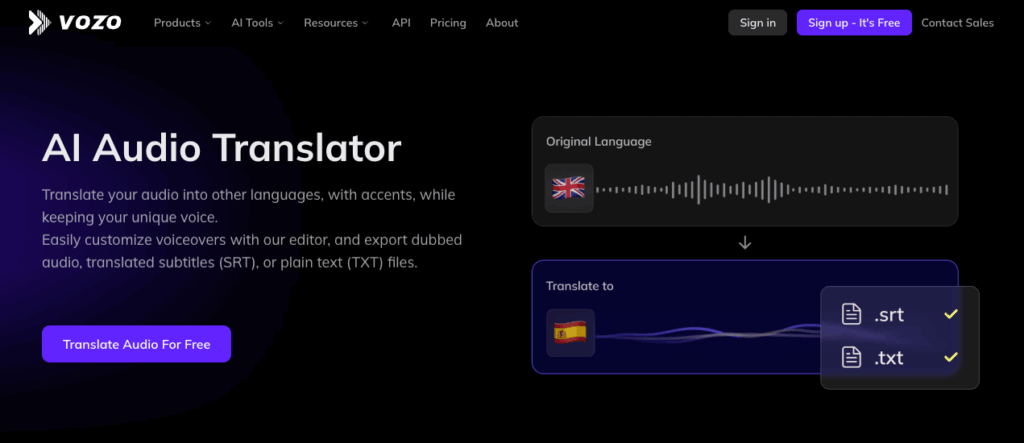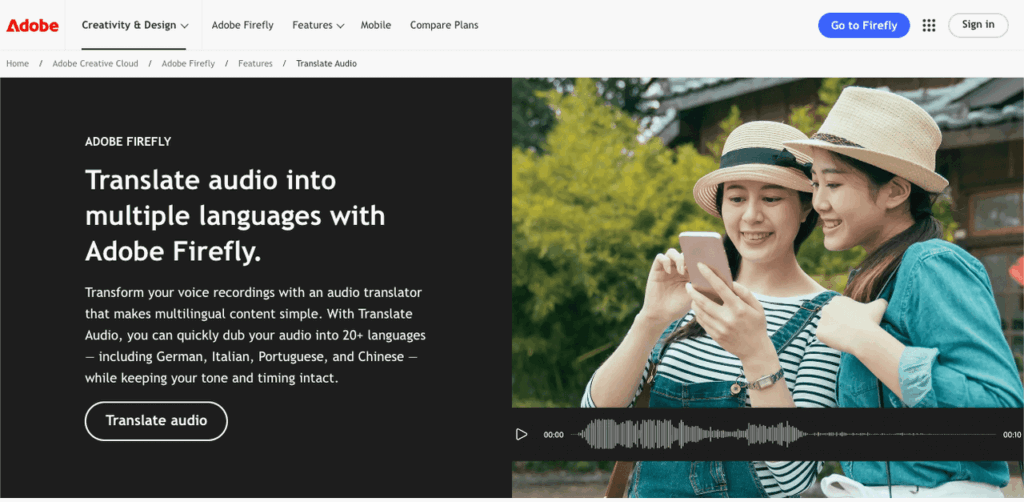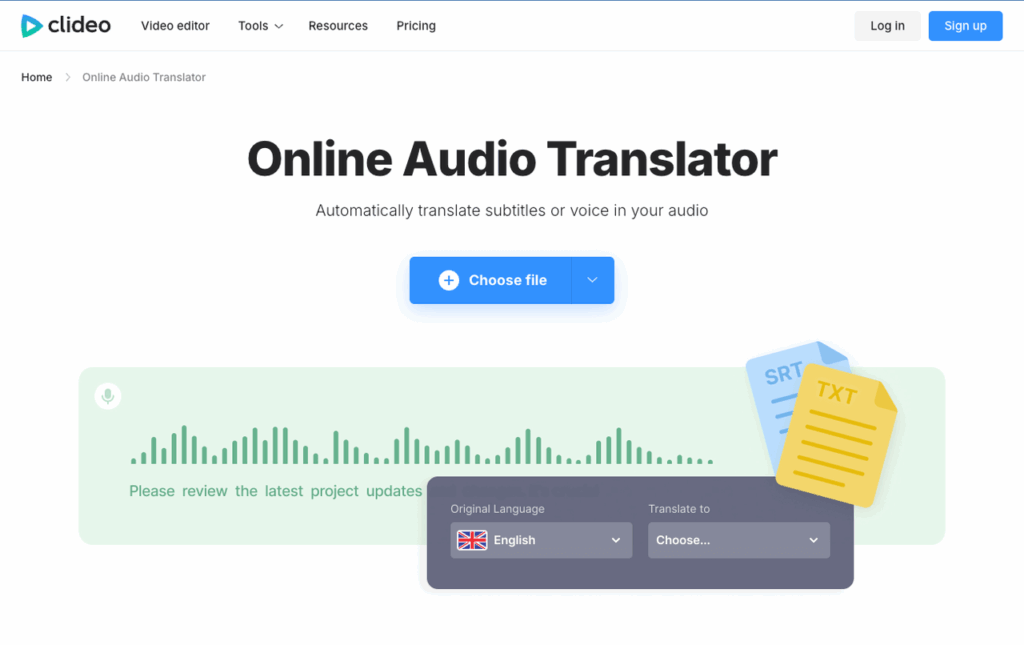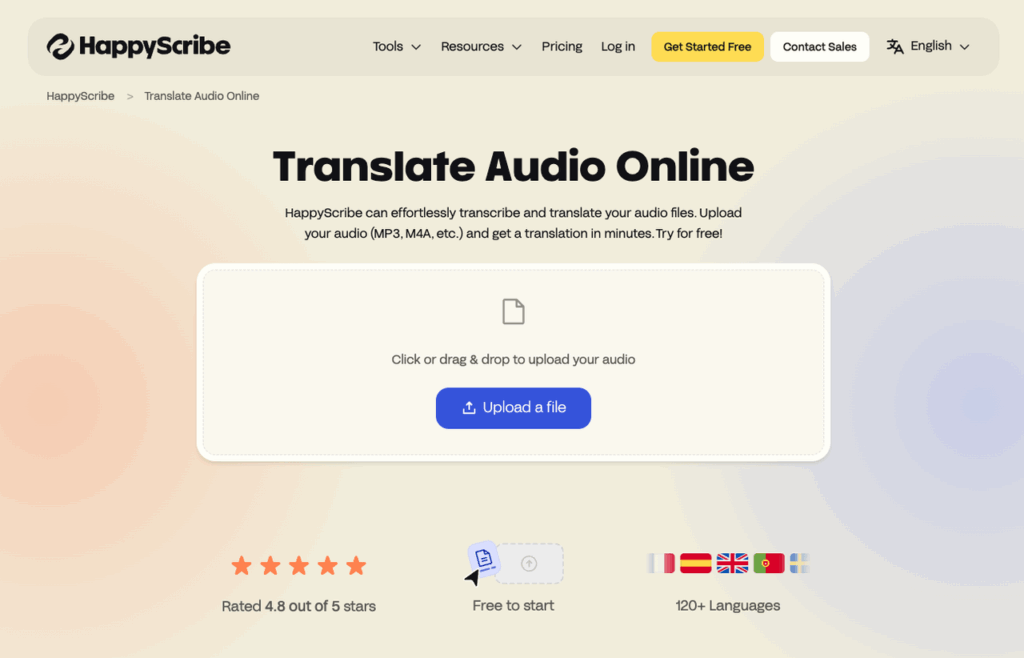Introduction
Your voice is your brand. It’s what connects listeners to your podcast, course, or company message. But what if that voice could speak any language?
For years, taking audio multilingual meant costly studio time and hiring voice actors who never quite matched your style. Today, AI-powered editing platforms have completely changed the game. These are not simple mobile apps; they are powerful online tools designed for creators.
You can now upload a finished audio file and get two revolutionary outputs:
- Instant Translated Transcripts: An editable, timestamped script in dozens of languages, perfect for integrating into your workflow as subtitles or articles.
- Lifelike AI Dubbing: A fully translated audio track, often created using an AI clone of your own voice to maintain perfect consistency and authenticity.
But which platforms actually deliver on this promise? To find out, I uploaded the same 15-minute podcast episode to the top contenders of 2025. This guide cuts through the hype to show you which AI tools are truly ready for your editing workflow and which ones are just noise.
Our Testing Criteria: How We Judged the Audio Translator Platforms
To find the best platform, I put each one through the same rigorous test: translating the same 15-minute, two-speaker podcast. I evaluated them based on four key areas:
1. Accuracy A translation is useless if it’s wrong. I split this into two parts:
- Transcription: How well did the AI convert speech to text? I checked its performance on jargon, accents, and overlapping speakers, aiming for a low Word Error Rate (WER).
- Translation: Did the platform produce a natural-sounding translation that captured context and nuance, or just a literal, word-for-word output?
2. Audio Quality & Voice Cloning For platforms offering AI dubbing, this was the “wow factor.”
- Naturalness & Emotion: Did the AI voices sound human? Crucially, did they preserve the original speaker’s energy and emotion, or did they sound flat and robotic?
- Multi-Speaker Handling: This was a key test. Could the platform correctly identify the two different speakers, create distinct and convincing voice clones for each, and maintain their vocal consistency throughout the file?
3. Workflow & Features A great tool should be easy to use. I assessed:
- Speed & Usability: How intuitive was the interface and how quickly did it process the file? Did it support common formats like MP3 and WAV?
- Editing & Exports: How easy was it to review and correct the transcript? Could I export essential files like timestamped transcripts and subtitles (.SRT)?
- Speaker Identification: Did the tool automatically label speakers in the transcript, saving significant editing time?
4. Pricing & Value What do you actually get for your money?
- Pricing Model: Was it a straightforward pay-per-minute system or a more complex subscription with credits?
- Return on Investment: Was a higher price justified by superior accuracy, better features, and significant time saved? The goal was to find the best results for any budget.
Deep Dive: Reviewing the Top Contenders For Audio Translator
Vozo — The Best Overall for Audio Translation

After testing a slate of tools, Vozo was the one that made me say, “Okay, this is the future.” It wasn’t just incrementally better than its competitors; it felt like a generational leap forward. It excels across the board, combining stunning accuracy, lifelike voice cloning, and a workflow that respects your time, making it my undisputed top recommendation.
What We Liked:
- Accuracy That Actually Saves Time: Vozo’s accuracy was a lifesaver. My 15-minute test podcast included tricky tech jargon and a moment where both speakers accidentally talked over each other. To my surprise, Vozo was one of the only platforms that transcribed this difficult section almost perfectly on the first pass. The final translation also felt human—it correctly interpreted an English idiom that other tools had botched with a literal, nonsensical translation.
- Voice Cloning That Preserves Personality: This is where I was truly impressed. One of my podcast speakers has a very energetic, upbeat delivery, and I was skeptical any AI could replicate it. Yet, Vozo’s voice clone captured that excitement perfectly, while also creating a clearly distinct and convincing voice for the second, more reserved speaker. It didn’t just translate the words; it translated the personalities.
- A Workflow That Just Works: The user experience is as polished as the results. I dragged my MP3 file into the browser, and the entire 15-minute file was processed and ready for review in under five minutes. Making a few minor tweaks in their timeline editor before exporting the final SRT file was incredibly intuitive—no tutorials needed.
Pricing:
Vozo uses a flexible ‘points’ system, with plans starting around $19/month. For me, value is a no-brainer. The hours I would have spent fixing a messy transcript from another service are easily worth the investment.
Bottom Line:
If you want a tool that delivers professional results without a headache, Vozo is it. After all my testing, this is the platform I would choose for my own projects, hands down.
Adobe Firefly — The Reliable Choice for Enterprise

For teams and creators already embedded in the Adobe Creative Cloud ecosystem, Adobe Firefly’s audio translation is a compelling and incredibly convenient option. While it may not have the detailed controls of a dedicated platform like Vozo, its strength lies in its simplicity and seamless integration with workflows that professionals already use every day in applications like Premiere Pro.
What We Liked:
- “One-Shot” Simplicity: My experience with Firefly was refreshingly straightforward. You upload your audio or video file, select your target language, and hit “Generate.” There’s no complex editor or timeline to manage. Within minutes, it delivered a high-quality translation of my test podcast. For enterprise teams on a tight deadline, this speed and ease-of-use are a massive advantage.
- Solid Translation Quality: I was impressed with the quality of the translation. Firefly handled the tone and pacing of the original speakers well, producing an output that was accurate and natural-sounding. While it currently only supports a single speaker for the best results, it did a surprisingly good job of distinguishing the two voices in my test file.
- Ecosystem Integration: This is Firefly’s killer feature. If you’re editing a video in Premiere Pro, you can access Firefly’s translation capabilities directly within the application. This eliminates the need to export and re-import files, saving valuable time and streamlining the entire production process.
What to Consider:
- Lack of an Editor: The “one-shot” approach is a double-edged sword. If you need to make manual corrections or fine-tune the translation, you’re out of luck. This makes it less suitable for projects that require a high degree of precision or creative control.
- Pricing Model: Firefly uses a “generative credits” system, which can be a bit confusing. You get a certain number of credits per month depending on your subscription plan, and these are used for all of Firefly’s features, not just audio translation. For example, the Firefly Standard plan at $9.99/month includes 2,000 credits, which is enough for about six minutes of audio translation.
Bottom Line:
Adobe Firefly is a rock-solid choice for enterprise users and existing Adobe customers. Its ease of use and seamless integration into the Creative Cloud workflow make it an incredibly efficient tool for translating audio and video content. While it may lack the advanced features of more specialized platforms, its convenience and reliability are hard to beat, especially for teams that prioritize speed and efficiency.
Clideo — The Budget Choice for Quick Audio Results

Not every project demands a high-end, emotionally resonant voice clone. Sometimes, you just need a translation done now, and you need to do a lot of them without breaking the bank. For that specific niche, Clideo carves out a compelling space. It’s a no-frills tool that prioritizes speed and volume over polish.
What We Liked:
- Unbeatable Pricing: This is Clideo’s main draw. For a flat fee of around $8 per month, you get unlimited audio dubbing. For anyone who needs to process a high volume of short clips, this pricing model is incredibly attractive and something the premium services simply can’t match.
- Lightning-Fast Simplicity: Clideo is built for speed. The interface is dead simple: upload your clip, pick a language, and generate. In my tests with shorter, one-to-two-minute audio segments, the process was incredibly fast and efficient. It’s designed for users who want to be in and out in minutes.
What to Consider:
- Robotic Voices & No Cloning: To meet its price point, Clideo makes significant compromises on audio quality. The service uses generic, robotic text-to-speech voices and does not offer any voice cloning. The final audio is understandable but lacks any human warmth or emotion.
- No Editing Capabilities: What you get is what you get. Clideo doesn’t offer an editor, so you can’t correct transcription errors or tweak the translation. This makes it unsuitable for any content where accuracy is critical.
- Struggles with Longer Files: As advertised, this tool is for short clips. When I uploaded my standard 15-minute test podcast, the service became unstable and struggled to process the file. It’s definitely best for audio under the five-minute mark.
Bottom Line:
Clideo is the definition of a niche tool. I wouldn’t use it for a podcast, a marketing video, or any public-facing content. However, if you have a massive batch of short, internal audio clips (like training snippets or social media replies) and your only priorities are cost and speed, Clideo is a valid and highly economical choice.
Happy Scribe — The Specialist for Transcripts and Subtitles

Happy Scribe is a different kind of tool in this lineup. It’s not for creating dubbed audio, but for users whose end goal is a highly accurate text translation of their audio—perfect for articles, show notes, and, most importantly, subtitles. It’s a specialized tool that focuses on perfecting the text, and it does that job very well.
What We Liked:
- A Focus on Text Perfection: My experience with Happy Scribe was impressive. It’s a two-step process: first, it transcribes the audio, then it translates the text. The initial AI transcription was solid, but what sets Happy Scribe apart is its interactive editor. Before translating, I was able to easily review the transcript, assign speaker names, and correct a few minor errors. This ensured the final translation was based on a flawless source text.
- Decent Translation Accuracy: Once I finalized the transcript, the translation was generated almost instantly. The quality was decent and captured the meaning of the conversation well. While it didn’t have the nuanced, natural flow of a top-tier AI like Vozo, it was more than sufficient for clear and accurate subtitles.
- Excellent Export Options: The platform is built for creators who need text-based outputs. I could easily export the final translation as a plain text file, or, more usefully, as timestamped SRT or VTT files, which are the industry standards for video subtitles.
What to Consider:
- No Audio Dubbing: This is the most important distinction. Happy Scribe is purely a transcription and text-translation service. You cannot generate any dubbed audio or voice clones. If you need an audio file as your final product, you’ll have to look elsewhere.
- Pricing Is Per-Minute: Unlike a flat subscription, Happy Scribe charges by the minute, with different rates for their automated and human-powered services. While the AI service is affordable, costs can add up if you’re processing a high volume of content.
Bottom Line:
Happy Scribe is the perfect tool for a specific job. If you need to turn your podcast, interview, or video into an accurate, well-formatted article or a perfectly synchronized subtitle file, it’s one of the best out there. Its strength lies in its excellent editor and reliable text outputs. However, if your goal is to create dubbed audio, this isn’t the tool for you.
Final Thoughts: Which Audio Translator is Right for You?
As we’ve seen, the world of AI audio translation is incredibly diverse. The “best” platform isn’t a one-size-fits-all answer; it truly depends on your specific needs, budget, and the final product you want to create. After hours of testing, here is my final breakdown to help you choose.
A Quick Guide to Your Perfect Tool:
- For the Best Overall Quality: Vozo If you need top-tier accuracy, emotionally resonant voice cloning, and a professional workflow, Vozo is the undisputed champion. It’s the tool I’d choose for my most important projects.
- For Adobe Creative Cloud Users: Adobe Firefly If your workflow lives inside Premiere Pro, Firefly is a no-brainer. Its seamless integration and “one-shot” simplicity make it the most efficient choice for video editors and enterprise teams already in the Adobe ecosystem.
- For Transcripts and Subtitles Only: Happy Scribe If your end goal is a text file—like an article or an
.SRTfile for subtitles—HappyScribe is your specialist. It forgoes audio dubbing to focus on providing a fantastic text editor and highly accurate transcriptions. - For Quick, High-Volume Clips: Clideo If you need to process a large number of short audio clips on a tight budget, Clideo’s unlimited plan is unbeatable. Just be prepared for robotic voices and no editing capabilities; it’s a tool that prioritizes quantity over quality.
The pace of innovation in AI is staggering, and these tools are only getting better. My best advice is to identify your primary goal, use this guide as a starting point, and take advantage of the free trials offered by these platforms. Upload a sample of your own content and see for yourself which tool best fits your workflow. Happy translating!


